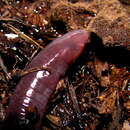Distribution
provided by IABIN
Present in some localities of the States of Paraná, Rio Grande do Sul and São Paulo, Brazil; in Province of Misiones in Argentina and Departments of Alto Paraná and Itapúa in Paraguay.
- author
- Esteban O. Lavilla
- editor
- Diego Arrieta
Molecular Biology
provided by IABIN
Ácidos diterpênicos e beta-cariofileno (32)
Diagnostic Description
provided by IABIN
Description of the holotype The head has been dissected, the tongue and lower jaws are nearly destroyed, most of the teeth are missing, but otherwise the specimen is in good condition. The color is nearly uniform grayish brown. The lips of the vent and the area over the eye-tentacle groove are faintly lighter in coloration. The eyes are not visible externally, possibly because of the age of the specimen, but they are not covered with bone. The tentacular aperture is below and anterior to the eye, close to the margin of the upper lip. The nostrils are visible from above. The sides of the head converge to an acutely rounded snout. The snout projects 2.2 mm in front of the subterminal mouth. The two collars are distinct. The first collar has a short, indistinct, dorsal, transverse groove. The second collar has a distinct, longer, dorsal, transverse groove. The second collar is fused with the first annulus ventrally. The annuli are fused middorsally, and many are fused midventrally. There are 131 primary and no secondary annuli. There are no scales. The body ends with a rounded terminal shield 8.3 mm long, supported by vertebrae. There are 141 vertebrae. The circular vent opens ventrally in the posterior half of the terminal shield. The tongue appears to have been smooth and narrowly attached to the gum in front, but this is uncertain because of damage. and are based largely on counts of empty sockets. The teeth are monocuspid. Vomeropalatine teeth 21; dentary teeth 22; premaxillary-maxillary teeth 13. There are no splenial teeth. Measurements of the holotype (in mm): Total length 472; body width 10; head length 10.6; head width 6.5; interorbital distance 4.0; internarial distance 2.2; eye-narial distance 4.1; eye-tentacle distance 0.7; tentacle-narial distance 3.3; snout length 2.2; terminal shield length 8.3. Variation There is no evident sexual dimorphism. All specimens have a faint dorsal, transverse groove on the first collar. The tongue is clearly attached narrowly to the gum in front in all specimens (undeterminable in holotype), and they all lack narial plugs. The terminal shield is indistinct in smaller specimens. Freshly preserved specimens have creamcolored chins and vent margins, and all have a light-colored tract surrounding the eye and tentacular aperture. The eye is faintly visible externally on all specimens except the very old holotype. Small specimens do not have an anterior diastema between the two vomeropalatine series of teeth, but larger specimens do.
- author
- Esteban O. Lavilla
- editor
- Diego Arrieta
Conservation Status
provided by IABIN
DD. Data Deficient. Listed how "Dados insuficientes" (DD) in the Lista Vermelha do Estado do Paraná and how "Atención Especial" in Argentina.
- author
- Esteban O. Lavilla
- editor
- Diego Arrieta
Luetkenotyphlus brasiliensis: Brief Summary
provided by wikipedia EN
Luetkenotyphlus brasiliensis, the São Paulo caecilian, is a species of caecilian in the family Siphonopidae. It is found in Misiones Province in northern Argentina and northwards to São Paulo state in Brazil; it likely occurs in adjacent Paraguay.
Luetkenotyphlus brasiliensis is a poorly known species. It probably inhabits forest, but it has also been found in urban gardens. This suggests that it is somewhat adaptable species.
- license
- cc-by-sa-3.0
- copyright
- Wikipedia authors and editors

